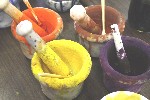Dyeing with Fresh Leaf Indigo ... continued In the Turkey Red Journal (Vol. 13, Issue 2), Rhoda Braunschweig and I described growing and dyeing with Polygonum tinctorium, also called Japanese Indigo or Dyer's Knotweed. After writing that article, I thought it would be interesting to test the light-fastness of this dye, so in August 2008, I dyed yarn for a knitted wool hat that I planned to wear during the winter months. I began by dyeing white as well as three shades of gray Shetland yarn, using the fresh leaf indigo recipes described in a Turkey Red Journal article. Simmering white yarn in leftover juice from blender-pulverized indigo leaves resulted in a yellow color. The dark green yarn (on the left in the above right photo) is the yellow yarn over-dyed in a traditional fresh leaf indigo vat. The rest of the colors are white or gray yarns dipped in a series of dye baths of freshly pulverized leaves until I was satisfied with the color.
To test the light fastness of the dye, I had taped a lock of blue-green wool, dyed using the blender method, to a sunny window for two months during the previous winter. The color faded from blue-green to a more common indigo blue. I wanted to see how these colors held up to more normal, everyday light exposures. To test this, I knit the yarns into a hat, using techniques described in Domino Knitting by Vivian Hoxbro. I wore the hat all winter, and when it was not being worn, hung it in a light, but not directly sunlit area. It hung there all summer, too.
After a year, the hat still looks good, and the overall impression is of little change. There are differences however, when the outside of the hat is compared to the inside and to leftover yarn that had been stored in the dark. Although the yellow and dark green show no change, the two darker grays have lost their very slight original greenish cast, and now appear gray. The lighter gray and the two blue-greens on white yarn have faded noticeably (compare the colors at the top of the hat, in the two photos above), but not disastrously. The darker blue-green is now more blue than green, having changed in a way similar to the yarn sample in the more intense window test.
By Ruth Cadoret
The hat in 2008, showing original color values.
The hat in 2009, after being worn and exposed to sunlight.


Photograph Copyright by Ruth Cadoret
Photograph Copyright by Ruth Cadoret
 Turkey Red Journal
Turkey Red Journal

| Volume 15 Issue 1 | A Journal Dedicated to Natural Dyes | Fall 2009 |

Ground pigments in John Marshall's workshop
Photograph Copyright by Heather Clark Hilliard
In this Issue
Articles:
• Los Colores ... In Taos!
• Introduction to Common
New Mexico Dye Lichens
• Close Call: Saving
Japanese Indigo
Nature's Gallery:
• Jaime Skolfield